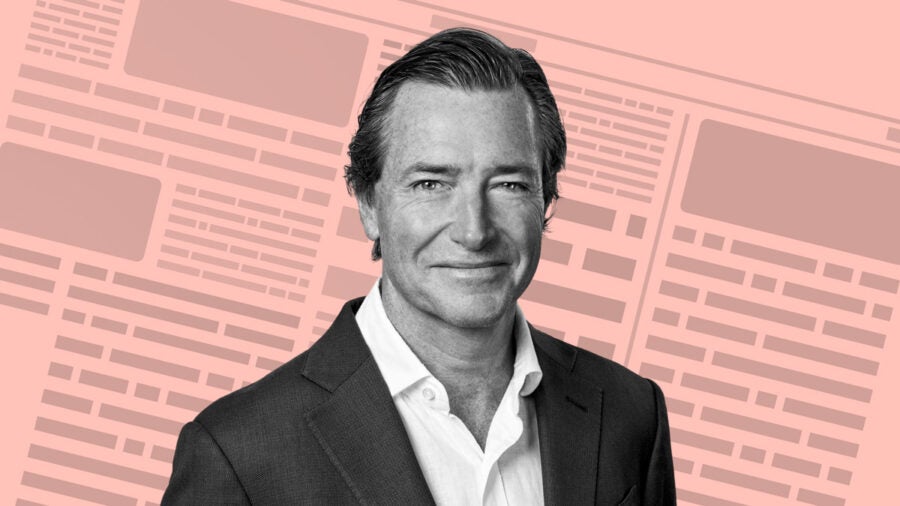
The Financial Times, says its CEO John Ridding, has “always aimed to be a bit different and a bit special.” When it launched in 1888 all newspapers were printed in black and white, but five years later it pulled off what Ridding terms a “marketing masterstroke” with its decision to publish on light pink paper, tinged by clay sourced from the Bodelva Pit in Cornwall (now the site of the Eden Project).
For the past 130 years, Ridding says, the pink colour scheme has helped to differentiate the FT from competitors and define an “instantly recognisable” global brand.
It is so important to the company that even its headquarters, the Grade II-listed Bracken House in Blackfriars, central London, is built from specially selected pink sandstone.
While imposing from the outside, the interior of building feels halfway between a modern, tech-savvy office and a grand, luxury hotel. On the ground floor, there is a museum that charts the newspaper’s rise, while the rooftop houses a garden and picnic space with a stunning view of St Paul’s Cathedral.
Diversifying the FT without losing focus
The FT, of course, is best known as a business newspaper. It has 1.3 million subscribers worldwide across print and digital (which accounts for 90% of them), and claims 26 million passing readers online every month. But, as is the case for many media enterprises, it is expanding its remit.
But, Ridding stresses, while the “FT universe” may have expanded, its core focus remains the same. “We’ve always been a global business newspaper, but now we’re a global business newspaper that does other things as well.”
Business people don’t just do business
The company runs a range of live events and conferences, produces numerous podcasts and has a growing film and documentaries department. Last year, People You May Know, an 18-minute film about personal data and surveillance, was nominated for the Bafta award for Best Short Form Programme. “We’re seeing an awful lot of success with video and audio,” Ridding says. “They’re big areas of excitement.”
In addition to global business, the FT covers politics, lifestyle, travel, arts, sport, and fashion. According to an open-collared, corduroy-clad Ridding, this is an acknowledgement that “business people don’t just do business.”
The idea, Ridding suggests, is to be a “must-have publication” that can appeal to a broader range of people’s interests, while entwining these with the economic analysis the paper originally built its name on. The coverage of sport, for instance, is “more the business of sport”, than it is match reports and player injury news.
Using personal experience to make decisions
Were it not already clear, Ridding is a company man. The Oxford University graduate joined the FT in 1988 as a news reporter, before rising through the editorial ranks covering business in the UK, South Korea and France. He was appointed managing editor in 1999 and became CEO in 2006.
John Ridding’s CV

2006-present: CEO
2003-06: publisher, FT Asia; chairman, Pearson Asia
2001-03: deputy editor
1999-2000: managing editor
1998-99: deputy managing editor
1995-98: Paris correspondent
1994-95: deputy features editor
1991-94: Korea correspondent
1990-91: UK companies reporter
1988-90: reporter, world desk
1987-1988: consultant
Does being a former journalist help him have a better understanding of the newspaper? “Totally,” he says. “I think it’s fair to say I will always miss writing, I loved journalism and still love journalism. But, then again, I don’t know if I miss the deadline fever!”
Ridding believes that the experience and insight gained from his own career in journalism means he is able to take a more rounded view when evaluating business decisions and whether to support coverage that has the “potential to get a bit litigious”. He points to the FT’s “fearless” reporting on Wirecard, the disgraced German payments company that filed for insolvency after a series of accounting malpractices.
“You know, we received some quite aggressive threats from lawyers,” Ridding recalls. “But we have full confidence in our fantastic team of journalists, not least our wonderful editor [Roula Khalaf]. I think having that sense of purpose of what we do and the instinct to actually encourage them to take risks, that impulse to support investigative journalism you get from having the newsroom connection.”
The enduring importance of good journalism
Since he started as a reporter, people have been telling Ridding that journalism is dying. But the 57-year-old believes that a “robust and reliable” fourth estate is vital.
“We’ve had some pretty big challenges,” he says. “We had the global financial crisis… and recently it does seem that the crises tend to come along more regularly and in a bigger fashion. No one could have predicted Covid or the [Russian] invasion of Ukraine.”
Newsrooms are, Ridding adds, “very, very busy. I think this meta theme [of the need for good journalism] is because the world is in a bit of a mess. The demand [for fast and accurate information] has been created by the proliferation of fake news. There is a need for trusted guides.”

But what about the need for physical newspapers? The vast majority of the FT’s subscribers and revenues are digital. Its print circulation was just 128,794 in December 2022, according to the Audit Bureau of Circulations.
Despite the format imbalance, there are no plans to abandon the print product, which Ridding claims has “actually grown in sales volume. In recent years, we’ve had an incredibly loyal audience in print. I guess you could probably count on one hand the number of publications that have achieved that.”
Nevertheless, it makes sense that evolving its digital offering is the FT’s immediate priority. For Ridding, one of the key battlegrounds for digital media publishers going forward is data. The FT has invested heavily in its data journalism team and stresses the importance of bringing information “to life”.
Interactive data graphics, he observes, are eminently shareable on social media. “I think our biggest-ever consumed piece of journalism was our Covid tracker, which was an innovation that made a complex and evolving news story more accessible. There is a huge demand for audiences to have information displayed in compelling and dynamic ways.”
Would the FT consider being on TikTok to attract new, younger readers from Gen Z? Ridding says the publication is “open-minded. At the moment, we’ve got lots of other things going on and there’s only so much you can do at one time. We’re not saying no, just not now.”
Making a premium product more accessible
Depending on the digital, print or combined package selected, FT subscribers can pay up to £754 a year. There are concessions for students and a limited-access option called The FT Edit that collates eight “essential” articles daily for £4.99 a month.
The FT has a newsstand price of £3.50, while the FT Weekend edition is £4.80. It charges for attendance of most of its events and conferences, but does not charge for the majority of its audio-visual content.

As a “premium product”, Ridding believes the FT is priced fairly but appreciates that not everyone can afford it, particularly within the context of the cost-of-living crisis.
The FT Edit, he says, was launched as a more affordable window into the publication, which may convince its readers to step up their commitment later on. The largely free audio-visual offering, meanwhile, helps to increase brand awareness.
Attracting and retaining top talent
A strong brand is key for the business. In 2015, Nikkei, the Japanese media conglomerate, bought the FT from previous owner Pearson for £844m. Ridding believes that Nikkei’s refusal to panic “even in turbulent times” has contributed significantly to the newspaper’s attractiveness as an employer. Every decision around recruitment or pay is made with a long-term perspective, he says.
Ridding argues that steady and sustained investment, even during Covid, showed that Nikkei is guided by “strategy, rather than circumstances”. But the FT does still take circumstances into account. In September, in response to the cost-of-living crisis, every member of UK staff received a one-off payment of £1,800.
Three months later, the FT negotiated with union delegates over an above-inflation pay deal for the lowest-paid editorial staff at the company. Journalists earning £42,000 or below annually received a consolidated pay rise of £4,200, while those earning more than £42,000 but less than £50,001 received a £10% increase on their salaries.
I loved journalism and still love journalism. But, then again, I don’t miss the deadline fever!
The pay rises were lower for those on higher wages. FT journalists earning between £50,001 and £60,000 received an 8.5% rise, while those earning between £60,001 and £70,000 got 8%. For journalists making between £70,0001 and £80,000, there was a pay increase of £5,250 and for those making more than that, £5,000.
But, Ridding notes, the FT’s mission to be viewed as a destination employer within the media industry is about more than money. “The expectations of employees are high [when it comes to perks and benefits], and so they should be,” he says. “I also believe they want to work for an organisation that has the right values, and I believe we do, including on subjects like the environment and sustainability.”
On the FT’s workforce diversity, Ridding says “it’s a work in progress, but one that we take very seriously.” According to its 2021 diversity and inclusion report, of the FT’s global workforce 53.7% are women, including nearly half (46.7%) of 598 the editorial staff. Nearly a quarter (23.6%) of the FT’s global workforce identify as an ethnic minority, but only 13% at a senior management level.
Where other media outlets might be guilty of simply trading on their name and taking advantage of a pipeline of wide-eyed graduates who just hope to write for a living, Ridding insists that the FT “won’t just sit back.” He adds: “We’re extremely active in looking for talent and encouraging applications from where we might not traditionally receive them.”
The FT, AI and the future
Rather than fearing artificial intelligence, Ridding says the FT wants to understand it, use it and hold its proprietors accountable. Earlier this month, on the guidance of Khalaf, the FT appointed its first AI editor in Madhumita Murgia. “That was a bold decision by Roula,” he says approvingly.
Ridding does not doubt AI’s potential to be “powerful and transformative”. In fact, he is excited by the efficiencies it might drive in the newsroom, through better capabilities to transcribe interviews, for example.
But, in terms of a potential threat to content production, the 35-year FT veteran who has played a key role in shaping the publication’s history retains full confidence in its future. “If you ask ChatGPT to write an essay, or a story, does it do it well? ChatGPT isn’t going to break a story. It’s never going to be [the FT’s chief economics commentator] Martin Wolf. There’s a level of journalism where the FT plays and operates, and that is safe.”

The Financial Times, says its CEO John Ridding, has “always aimed to be a bit different and a bit special.” When it launched in 1888 all newspapers were printed in black and white, but five years later it pulled off what Ridding terms a “marketing masterstroke” with its decision to publish on light pink paper, tinged by clay sourced from the Bodelva Pit in Cornwall (now the site of the Eden Project).
For the past 130 years, Ridding says, the pink colour scheme has helped to differentiate the FT from competitors and define an “instantly recognisable” global brand.
It is so important to the company that even its headquarters, the Grade II-listed Bracken House in Blackfriars, central London, is built from specially selected pink sandstone.
